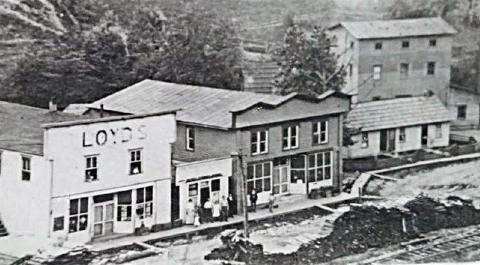
Historic Exchange WV was a bustling railroad town 125
years ago, now faded to the sound of whispering ghosts
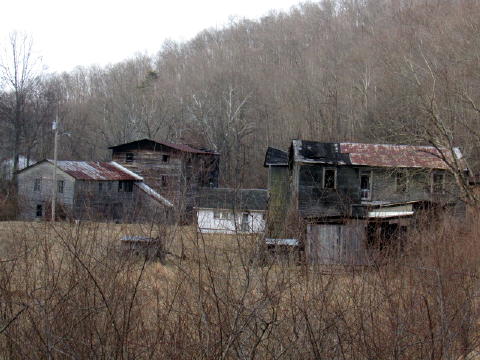
In 2022 that which remains is a reminder that
all that humans build will return to mother nature
- "So empty is the glory that the world builds"
By Bob Weaver 2022
The once busy and thriving Village of Exchange in Braxton County has faded from its glory days and is now a ghost town, standing along a once busy railway which ran through the area since 1900.
The Elk River Railroad was a short line which runs for 61 miles between Gilmer and Gassaway, although it was originally built in the late 19th century and was once part of the Coal and Coke Railway that ran from Charleston to Elkins, and later the Baltimore and Ohio Railroad.
Left behind is an assortment of old abandoned railroad cars with its ghostly old stores, station house and dwellings, a testament to the axiom that everything comes and everything goes.
The village is now on private property, not open for tours.
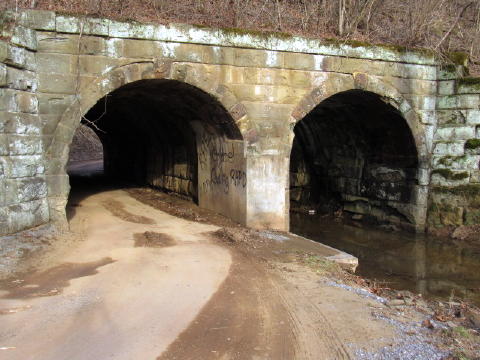
In the nearby faded village of Riffle, few
residents were aware it was the birthplace
of the infamous UFO story-teller Gray Barker.
QUICK TRIP THROUGH WHAT ONCE WAS
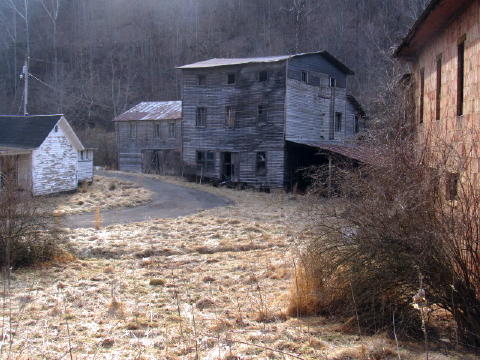
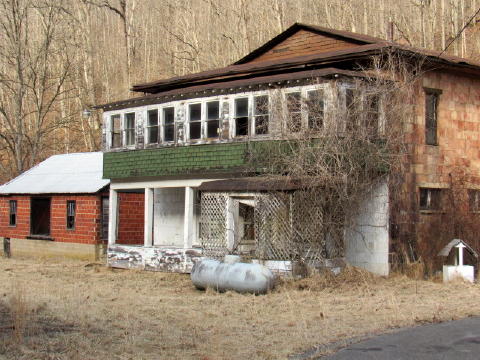
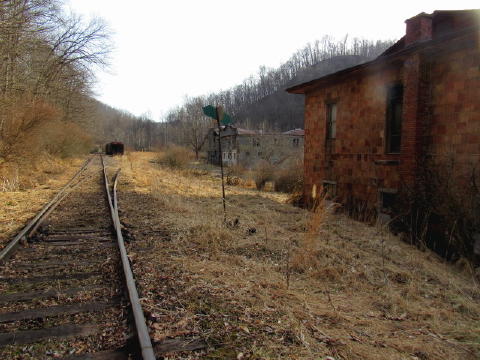
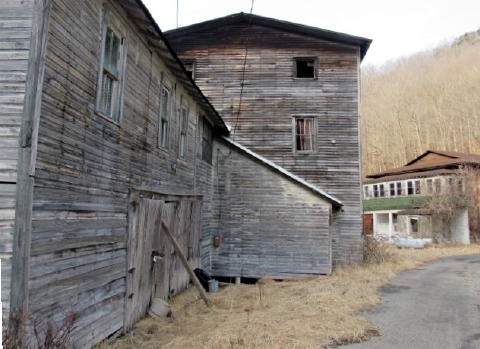
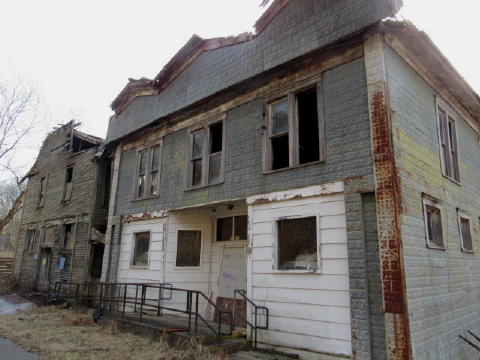
Exchange Community History (WVU)
Exchange is the center of a community on Cedar Creek in Braxton County, West Virginia. This creek includes many streams flowing down narrow valleys and separated by hills that were densely forested with poplar, oak, maple, beech, hickory, ash, sycamore, and other trees and bushes of very great variety with no roads or even trails. A number of these valleys come together in the vicinity of Exchange. The forks of Cedar was a prominent landmark in the early day.
This region once abounded with game such as deer, bear, wild turkey, squirrel and nearly every variety of fur bearing animal. The creeks had an abundance of fish so that it was a hunter's paradise long after other parts of the county had their first settlers.
The First Settlers
One of the huntsmen, Mr. O'Brien, left his name on many creeks. They were given such names as O'Brien.'s Fork or O'Brien's Run.
As early as 1811 Jacob Westfall, father of Eli, Jacob, Alfred, and William Westfall and of Mrs. Hank Bosley, settled near the mouth of Scots Fork and thus became the first permanent resident. A very large number of his offspring still remain in Braxton County.
In 1816 William, Abraham, and Isaac Sirk came from Virginia and settled at the Three Forks. (Their father and mother lived at the old Berry place.) While building their cabin they lived in a hollow sycamore tree near where the railroad crosses Cedar Creek . The level bottom between the railroad and the creek below the forks was cleared by them. They built their cabin near where W. N. Cutlip now lives. In 1838 the squatters' claim was sold to Samuel Cutlip and the Sirks, real pioneers, moved into Clay County.
John Riffle, father, of William and Jacob Riffle and of Mrs. Elijah Perkins, Mrs. Alph Westfall, Mrs. Lewis Kyer, Mrs. Arthur Kyer, and Mrs. Perry Kyer, came to Cedar Creek quite early and settled on Perkins' Fork at Riffle. The grand children and great grandchildren are numerous, and have played a large part in the history of Cedar Creek. About 1854 Aunt Katie Smith, sister of Isaac Sirk, with her four children, James, Henry, Felix, and Ann, came to the Middle Fork where O. J. Lloyd now lives.
Enoch Cunningham came to the Middle Fork about the same time and lived where W. A. Bosley now lives.
Isaac Hyer Lloyd, son of William H. and Julia Ann (Sirk) Lloyd, was born in Rockingham County, Virginia, in 1812. His father died and in 1815 his mother married Christian Hyer and the family moved to Flatwoods in Braxton County, then Harrison County. They lived on what has more recently been known as the Leonard Hyer farm. Leaving Virginia at the age of four years he lost connection with his family, remembering only one uncle, an Uncle John. According to Sutton's History, lsaac H. Lloyd and Mary Catherine McPherson were married May 23, 1837. Two years later they came to the Middle Fork where Victor Lloyd now lives. Here Isaac lived until his death in 1890. He was a man of industry and economy, and left a large family of children and grandchildren.
A year later, 1838, Leonard Hyer, a half-brother of Isaac H. Lloyd, and who married a sister of Mrs. Isaac Lloyd, came to the place where E. B. Lloyd now lives. This was his home many years.
The same year, 1840, Jacob Shaver, whose wife was a sister of Isaac Lloyd, came to Cedar Creek. He was the father of sixteen children. The descendants of these children have become numerous and have played a large part in the community life.
In 1838 Samuel Cutlip, son of Henry Cutlip, married Rachel Brown and came to the Three Forks of Cedar Creek. He built his home at the mouth of Slab Camp. Samuel Cutlip was the father of Wilson, Addison, and Perry Cutlip. He was a man of resource, had studied law and medicine, and was for many years the lawyer and the doctor, known widely as Squire Cutlip. He built a water mill which stood for more than half a century, and was the first community center. He also traded in cattle and furs. He was the first to acquire land title by entry and purchase of squatter right, and had in all 2900 acres.
It must have been about this same time that Samuel Sands came to the place where his grandson, M. C. Sands, now lives.
The German migration to Steer Creek occurred in the year 1840. This migration included the ancestors of the Gerwigs, Engles, Whytsells, and Benders and other families who have contributed much to the development of the territory.
In the German colony that left Germany in 1838 there were four Gerwig brothers, Matthias, George Frederic, Jacob, and John. They first located in Baltimore but two years later, in 1840, Matthias and George Frederic came with the German colony to Steer Creek. George Frederic was noted for his very great strength. He married Juliana King. They had six children, Christian, Frederic, Caroline, Jacob, and Charlotte. After 80 years there were 39 grandchildren, 109 great grandchildren, and a total posterity of 293, almost all of which were farmers and noted for their thrift and industry.
William H. Bosley, father of Thomas, Lawson, Peyton, and James Bosley, married a daughter of Jacob Westfall and moved to Clout Run. His brother, James H. Bosley, came at the same time and a few years later, in 1852, another brother, Peter L. Bosley, came to the Bosley homestead where he lived until his death in 1914.
Jacob Heffner came from Pendleton County in 1850, and the Moyers families came about the same time.
Land Titles
The Smyth survey for 56,000 acres was patented in 1798. This survey included most of Exchange community. Later patents to settlers included portions of this same territory. The Smyth survey was acquired by a company in New York City. The title for many years was held by Dr. Willard Parker.
A Mr. Camp succeeded in 1838 in inducing the Virginia Legislature to enact a special tax titles law. Elijah Perkins became his agent in 1835. He collected surveys totaling 100,000 acres. In 1841 he paid taxes and began selling the land really as tax titles. Some who had squatter rights and government permits now bought the Camp title; others had only the latter claim. Later there followed years of bitter litigation with the holders of the Smyth survey, known as the New Yorkers. This was finally settled b: compromise, the residents paying 30 cents an acre for the Smyth title.
Industries
The first settlements began about the time of the industrial revolution. For many years most of the necessities of life had to be secured from the land. Forests were full of game. Corn and wheat were ground at the Cutlip mill. Flax and wool furnished clothing and beds. Home-tanned leather furnished shoes. Maple trees furnished sugar. Furniture was home made. For many years the nearest store was at Weston. It was not long before cattle and sheep were being driven to market. Later Sutton became the trading center after it became the county seat in 1856. Furs and ginseng were among the early exports. Cattle and sheep have been driven to market since 1840. Isaac H. Lloyd always had corn to sell by the grist and people came from all parts of the county to carry it away on horseback.
About 1878 the walnut timber began to be cut and floated down to Parkersburg. Poplar timber soon followed in the same way. James Shock, David Shock, James Riffle, Luther Hefner, Perry Cutlip, and Dock and William Perkins engaged in this work and the "log drive" was a great event in the eighties.
After the building of the Baltimore and Ohio Railroad in 1891, sawmills and stave mills removed much of the lumber, Coger being the principal shipping point. After the building of the Coal and Coke Railroad in 1906, stave making became the order of the day. Among those who operated saw and stave mills were Waggy and Company, Wesley Gerwig, Henry Duffield, Henry Henderson, the Lloyd brothers, M. L. Duvall, and Gum and Company.
Soon after the Civil War, Steve Taylor and Jacob Riffle erected a store near the old Cutlip Mill. This store changed owners several times. R. D. M. White bought of Riffle. He sold to E. W. Cutlip, and Cutlip in turn to the Hefner brothers. In 1884 Hefner brothers' store was burned. Later a new store was built near the mill by A. Bender and Son. This was afterward owned by
N. W. Hopkins and later by David Baker. After the burning of the old store, E. W. Cutlip built a new store at Cutlipville where it now stands. The old water mill having failed, a new mill was built and run at Cutlipville by Addison Simmons and Eli Goughenour. The community center shifted to that place for several years. Here was for a time a resident Doctor, L. L. McKinney and J. I. Hefner had a good hotel.
About the time the old Cutlip mill was discontinued in 1891, H. F. Shaver built a small water mill where Exchange now stands. Two years later, in 1893, Henry Gerwig built a store at Exchange. This store changed hands several times. Jacob Riffle, Henry Lloyd, Lloyd and Bender, and O. J. Lloyd were in the store business at short intervals.
In 1903 the Coal and Coke Railroad was surveyed; the grading was done in 1904; the steel was laid in 1905; and the first trains were run in 1906. From that time, Exchange became the community center.
Churches
The first church organized was at the home of Isaac Lloyd on Middle Fork, about 1843. There were six charter members; Isaac H. Lloyd and wife, Jacob Westfall and wife, Mrs. Jacob Shaver, and one other. Soon they were joined by Jacob Shaver, Leonard Hyer and wife, and John Riffle and wife. For seven years people came long distances to this church. John Bender who lived where W. K. Bender now lives was leading the class. The writer has been unable to learn the name of the first minister.
It was not long, however, until there were three preaching places: the home of Jacob Westfall, the schoolhouse on Middle Fork, and the schoolhouse on Perkins Fork, The first church building was the old log church called Pleasant Dale, built in 1877. The new Pleasant Dale Church was built in l898. The church at Lloydsville was built in 1893 and was dedicated on Christmas day.
There was a Methodist Protestant Church established at the old schoolhouse at the two forks, but the date is unknown. The schoolhouse at the three forks was a preaching place for Baptist, United Brethren, and Methodist Protestant churches for many years. The Methodist Protestant Church at Cutlipville was built in 1897.
The exact date of the organization of the Baptist Church is unknown to the writer but its beginning was due to Mrs. Wilson Cutlip and others soon after she came to Cedar Creek. The church was organized in the year 1889 and the church was built in 1896.
The Gerwigs and Engles were United Brethren and Matthias was for many years a local preacher. Most of the families among the early settlers were more or less connected with these Protestant churches.
Schools
J. W. Humphries taught a subscription school on the Middle Fork in 1863, one of the very last of its kind in the county. The schoolhouse stood at the line between the Jacob Shaver and the Leonard Hyer lands. Here in September, 1866, was taught by J. W. Humphries the first free school in Braxton County. The trustees of the school were Jacob Westfall, Jacob Shaver, and Jacob Riffle, living on the heads of the three forks of Cedar Creek. There was an old schoolhouse, (Campbell place Schoolhouse) date of erection unknown, that stood across the creek from Jacob Riffle's home. This was before the log schoolhouse on Perkins Fork was built. It was also a preaching place until 1877.
There was a log schoolhouse at the two forks. The creek has washed away the ground where it stood. The writer has no record of the date but it was a very old building In 1874 when W. K. Bender taught the last school in it. In the year 1875 the log schoolhouse was built at the three forks as was also the one on Middle Fork. Thad Cutlip taught the first school at the Three Forks. The schoolhouse was a preaching place and for many years on Sunday afternoons there was preaching and the young people came for miles. Singing schools were taught by Mr. Stannard and Mr. H. D. Engle. The singing was led by Luther Hefner, J. M. Cutlip, and others.
There was also another log schoolhouse as early as 1850 near Bonny on the Campbell Place.
Another activity of community interest housed in the old log schoolhouse at the Three Forks was a debating society. Leaders of these debates in the eighties were M. Wiesenfield, W. H. Bosley, N. W. Lloyd, E. W. Cutlip, John Cutlip, James Cutlip, and Joseph Cutlip. These debates were continued later at the Cutlipville schoolhouse with Bob Norris, N. W. Hopkins, W. G. Lloyd, and John I. Bender added to the list of contestants.
Roads
The first record of a public road is found in the minutes of the County Court for July 2, 1862. It reads: "Ordered that Havilah Shaver be appointed Surveyor of the road from the three forks of Cedar Creek up the middle fork of said creek to the head and down the Rush fork of Grannies Creek to its mouth and that Isaac Shaver, Henry Ulrich, Elliott McNemar, Hiram Foster, Alfred Westfall, Henry Smith, Felix Smith, Isaac Lloyd, and hands, Jacob Shaver and hands, John Crawford and Charles Corrick aid and assist said surveyor in keeping said road in repair."
Road building on Cedar Creek has been very difficult first because of the forests, second because the irregular stretches of level land were so valuable for farming that to avoid them the roads were built around them either in the creek or on the hillside. The high waters frequently washed out the roads. Later lumbering cut them into ruts. This continued for many years. In addition there have been irregular springs and landslides. Only in very recent years has there been a real program of road building to connect the community with other parts of the county by good automobile roads.
About the year 1880 a mail route was established between Sutton and Stouts Mill, with postoffices at Lloydsville and Cutlips. Julia Lloyd, now Mrs. H. E. Engle, was postmistress at Lloydsville and has held this office most of the time since. The first postmaster at Cutlips was M. Wiesenfield whose home was two miles from the post office. W. N. Cutlip soon succeeded him. In this office there were frequent changes until it was finally established at the store of E. W. Cutlip about 1890. The post office at Exchange was established August 5, 1904, with Mrs. Samantha Duffield as postmistress. The first quarter's cancellation of stamps was $10.29. Lester Gerwig, the present postmaster, succeeded to the office in December, 1904. The cancellation of stamps in 1921 was about $150.00 per quarter.
The Amos telephone line was built to Cutlipsville in 1895. The Citizens Telephone Company was organized and their lines built in 1907. The same year the flour mill was bought and enlarged by Lloyd Brothers.
In the eighties there was a blacksmith shop built at the three forks and since then there has always been adequate service of this kind.
=West Virginia Archives & History: Early Exchange Community: 1800s, Early 1900s
| 


